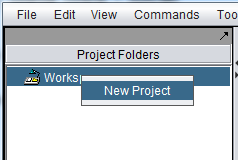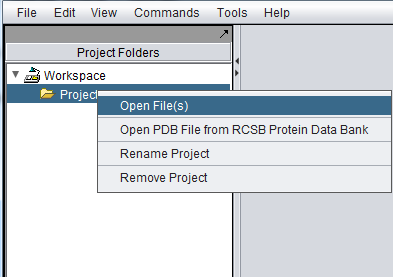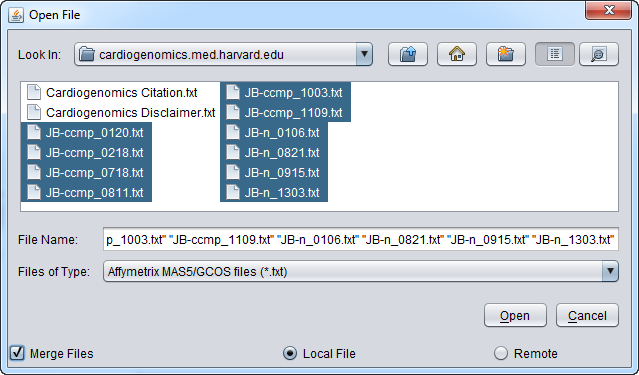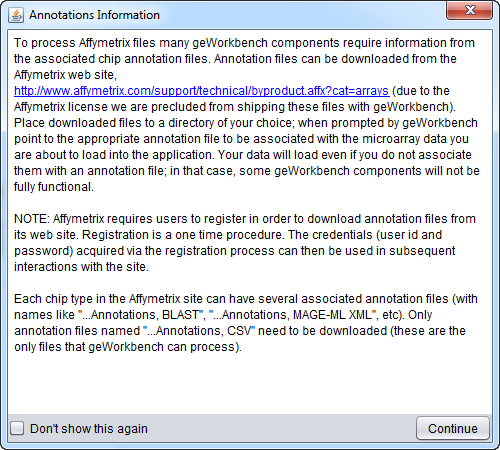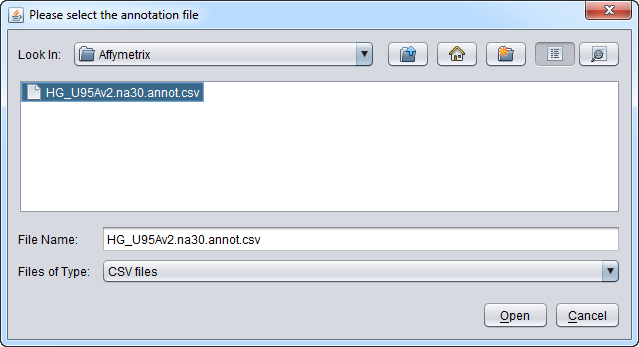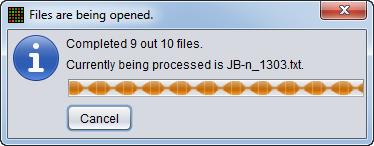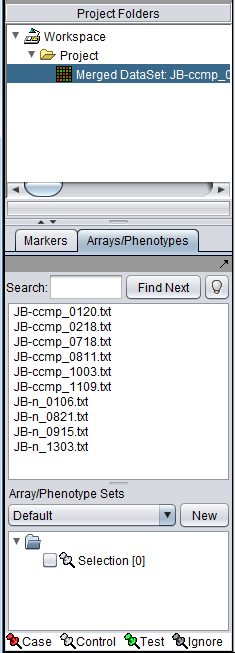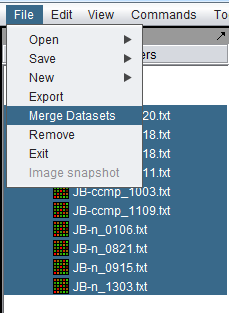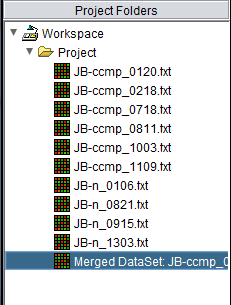Difference between revisions of "Local Data Files"
(→Supported data formats) |
|||
| Line 12: | Line 12: | ||
*Microarray | *Microarray | ||
**'''Affymetrix MAS5/GCOS''' files - produced by Affymetrix data analysis programs. | **'''Affymetrix MAS5/GCOS''' files - produced by Affymetrix data analysis programs. | ||
| − | **'''Affymetrix File Matrix''' - a geWorkbench spreadsheet-type multi-experiment format; this is the native file type created by geWorkbench from merged datasets. | + | **'''Affymetrix File Matrix''' - a geWorkbench spreadsheet-type multi-experiment format; this is the native file type created by geWorkbench from merged datasets. It can contain the data from any number of arrays in a spreadsheet-like "matrix" format. It also allows for the grouping of arrays into named subsets based on phenotypic criteria. Multiple such groups can be defined, each containing a different division of the arrays among named sets. geWorkbench can create files in this format from data read in in other formats. |
** '''GEO Soft formats''' | ** '''GEO Soft formats''' | ||
*** '''series''' files, e.g. GSE2189_family.soft. | *** '''series''' files, e.g. GSE2189_family.soft. | ||
| Line 30: | Line 30: | ||
Several of the expression file formats are described in detail on [[File_Formats| File Formats]] page. | Several of the expression file formats are described in detail on [[File_Formats| File Formats]] page. | ||
| − | |||
| − | |||
| − | |||
| − | |||
| − | |||
| − | |||
| − | |||
| − | |||
| − | |||
| − | |||
| − | |||
| − | |||
| − | |||
| − | |||
| − | |||
| − | |||
| − | |||
| − | |||
| − | |||
| − | |||
| − | |||
| − | |||
| − | |||
| − | |||
| − | |||
| − | |||
==Details of Tab-delimited data matrix format== | ==Details of Tab-delimited data matrix format== | ||
Revision as of 17:49, 17 June 2010
|
Home | Quick Start | Basics | Menu Bar | Preferences | Component Configuration Manager | Workspace | Information Panel | Local Data Files | File Formats | caArray | Array Sets | Marker Sets | Microarray Dataset Viewers | Filtering | Normalization | Tutorial Data | geWorkbench-web Tutorials |
Analysis Framework | ANOVA | ARACNe | BLAST | Cellular Networks KnowledgeBase | CeRNA/Hermes Query | Classification (KNN, WV) | Color Mosaic | Consensus Clustering | Cytoscape | Cupid | DeMAND | Expression Value Distribution | Fold-Change | Gene Ontology Term Analysis | Gene Ontology Viewer | GenomeSpace | genSpace | Grid Services | GSEA | Hierarchical Clustering | IDEA | Jmol | K-Means Clustering | LINCS Query | Marker Annotations | MarkUs | Master Regulator Analysis | (MRA-FET Method) | (MRA-MARINa Method) | MatrixREDUCE | MINDy | Pattern Discovery | PCA | Promoter Analysis | Pudge | SAM | Sequence Retriever | SkyBase | SkyLine | SOM | SVM | T-Test | Viper Analysis | Volcano Plot |
Contents
Overview
This chapter covers:
- Data file formats supported by geWorkbench
- Loading microarray data from local files, while merging the data into one data set.
- Merging data from several previously loaded microarray experiments.
Supported data formats
- Microarray
- Affymetrix MAS5/GCOS files - produced by Affymetrix data analysis programs.
- Affymetrix File Matrix - a geWorkbench spreadsheet-type multi-experiment format; this is the native file type created by geWorkbench from merged datasets. It can contain the data from any number of arrays in a spreadsheet-like "matrix" format. It also allows for the grouping of arrays into named subsets based on phenotypic criteria. Multiple such groups can be defined, each containing a different division of the arrays among named sets. geWorkbench can create files in this format from data read in in other formats.
- GEO Soft formats
- series files, e.g. GSE2189_family.soft.
- curated data matrix (GDS files), e.g. GDS507_sample.soft.
- series matrix files, e.g. GSE2189_series_matrix.txt.
- MAGE-TAB data matrix - this is an auxiliary MAGE-TAB data file type that can be used to contain summarized data from multiple arrays.
- Tab-delimited text (e.g. files exported by RMAExpress or other programs) - A simple columnar file format.
- Genepix .GPR files - Produced by a popular analysis program for two-color microarrays.
- Affymetrix CEL files - these files of probe level data can be viewed graphically in geWorkbench but not used directly for analysis.
- Other
- FASTA files. DNA or amino-acid sequence files in FASTA format.
- PDB files - protein 3-dimensional structure files can be viewed in the JMol Viewer in geWorkbench.
- NetBoost Edge List - used by a component still under development.
Detailed expression file formats
Several of the expression file formats are described in detail on File Formats page.
Details of Tab-delimited data matrix format
This simple tab-delimited format just contains array and marker names and the expression data. It does not contain any annotation, nor does it support any groupings of arrays. Unlike the example above, this format only supports a single value per marker per array. A second, confidence value is not supported.
Leading lines beginning with ! or # are taken to be comments and are discarded. The first line not beginning with ! or # is taken to be the column header line.
The first column contains the marker (e.g. probeset) names. Each name in this column must be unique. The remaining columns contain the data matrix as floating point numbers. The header line contains the array names. The column header for the first column can be any word, here "Probesets".
Probesets Array Name 1 Array Name 2 Array Name 3 Array Name 4 Array Name 5 markerID1 expression1-1 expression1-2 expression1-3 expression1-4 expression1-5 markerID2 expression2-1 expression2-2 expression2-3 expression2-4 expression2-5 markerID3 expression3-1 expression3-2 expression3-3 expression3-4 expression3-5 markerID4 expression4-1 expression4-2 expression4-3 expression4-4 expression4-5
Some microarray platforms can include multiple markers/probesets for some or many of the genes represented. If a data file contains e.g. gene symbols rather than individual marker names in the first column, any resulting duplicate appearance of such a label will prevent the file from being read in to geWorkbench.
Microrray data and merging datasets
When working with microarray data, all data to be analyzed must be present within one data node in a project. If the data exists as multiple files containing results from single arrays, the data must be merged into a single node before it can be used. geWorkbench can perform this merging step either at the time data is read in, or later in a separate step. Once merged, such a dataset can be saved to disk; it will be saved in the geWorkbench matrix file format.
Data merging will be covered in the local and remote data tutorials.
Tutorial: Loading microarray data files - local
In this example, we will load 10 individual Affymetrix MAS5 format files, and merge them into a single dataset. The origin of these file is described in the section Tutorial_-_Data.
Note that no Affymetrix annotation files are included in the geWorkbench distribution. The annotation file for the HG-U95Av2 array used in this example can be obtained from the Affymetrix website. See the instructions in the FAQ entry on this topic.
1. Right-click on the default Workspace entry in the Project Folders component.
2. Next, right-click on the new Project entry and select Open Files.
A file browser will appear with which you can select the files you wish to open. The default is to browse for local files, that is on your own computer. geWorkbench can also access data from caArray databases (the Remote option).
3. Here, we select the file type Affymetrix GCOS/MAS5 as shown.
4. Make sure to check the Merge files checkbox. This will create the merged data node as the files are read in.
5. We will select 10 MAS5 format text files from the directory data/cardiogenomics.med.harvard.edu, which is included within the geWorkbench installation.
6. Click Open.
A message will appear giving information about associating an annotation file with the dataset.
7. A file browser will then open with which you can, if you wish, select an annotation file matching your dataset. This is needed if you intend to use features of geWorkbench such as the Sequence Retriever or GO Terms component (Gene Ontology).
A status bar will display as the data is loaded:
8. The merged data set is listed in the Project folder. The individual arrays are shown below in the Arrays component.
Tutorial: Merging microarray data files after they have already been loaded.
If data files are not merged at the time they are read in, they can also be merged later, as long as they are from the same chip type.
1. Select the read-in data files that you want to merge.
2. Click on File in the menu bar, and choose Merge Datasets.
3. The result is a new data node containing the merged data. The original data nodes are still present.
